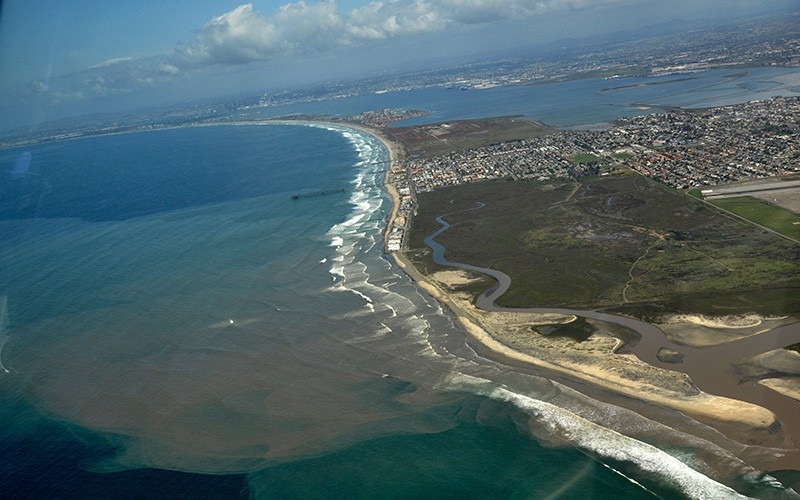According to recent research guided by the Scripps Institution of Oceanography at UC San Diego, coastal water pollution transfers to the atmosphere in the form of sea spray aerosol, which can reach people other than beachgoers, surfers, and swimmers.
 Polluted waters off Imperial Beach. Image Credit: WILDCOAST
Polluted waters off Imperial Beach. Image Credit: WILDCOAST
Rainfall along the US-Mexico border can cause problems for wastewater treatment, resulting in untreated sewage flowing into the Tijuana River and into the ocean in south Imperial Beach. For decades, this contaminated water input has resulted in chronic coastal water pollution in Imperial Beach.
According to new research, sewage-polluted coastal waters are transferred to the atmosphere in the form of sea spray aerosol, formed by breaking waves and bursting bubbles. Aerosolized seawater contains bacteria, viruses, and chemical compounds.
The results were published in the journal Environmental Science & Technology on March 2nd, 2023.
According to lead researcher Kim Prather, a Distinguished Chair in Atmospheric Chemistry and Distinguished Professor at Scripps Oceanography and UC San Diego’s Department of Chemistry and Biochemistry, the study comes in the middle of a winter in which an estimated 13 billion gallons of sewage-polluted waters have entered the ocean via the Tijuana River since December 28, 2022.
She is also the founding director of the NSF Center for Aerosol Impacts on Chemistry of the Environment (CAICE).
We’ve shown that up to three-quarters of the bacteria that you breathe in at Imperial Beach are coming from aerosolization of raw sewage in the surf zone. Coastal water pollution has been traditionally considered just a waterborne problem. People worry about swimming and surfing in it but not about breathing it in, even though the aerosols can travel long distances and expose many more people than those just at the beach or in the water.
Kim Prather, Distinguished Professor, Scripps Oceanography
Between January and May of 2019, the researchers sampled coastal aerosols at Imperial Beach as well as water from the Tijuana River. The researchers then used DNA sequencing and mass spectrometry to trace bacteria and chemical compounds in coastal aerosol to the sewage-polluted Tijuana River, which flows into coastal waters.
Aerosols from the sea were discovered to contain bacteria and chemicals from the Tijuana River. The group is now performing additional research to identify viruses and other airborne pathogens.
Prather and co-workers emphasize that their findings do not imply that people are becoming ill as a result of sewage in sea spray aerosol. Most bacteria and viruses are harmless, and the presence of bacteria in sea spray aerosol does not imply that pathogenic or non-pathogenic microbes become airborne. According to the authors, further research into infectivity, exposure levels, and other risk factors is required.
This research involved three different research groups collaborating to analyze the potential links between bacteria and chemicals in sea spray aerosol and sewage in the Tijuana River, guided by Prather in partnership with UC San Diego School of Medicine and Jacobs School of Engineering researcher Rob Knight, and Pieter Dorrestein of the UC San Diego Skaggs School of Pharmacy and Pharmaceutical Science, both affiliated with the Department of Pediatrics.
This research demonstrates that coastal communities are exposed to coastal water pollution even without entering polluted waters. More research is necessary to determine the level of risk posed to the public by aerosolized coastal water pollution. These findings provide further justification for prioritizing cleaning up coastal waters.
Matthew Pendergraft, Study Lead Author, Scripps Oceanography
Matthew Pendergraft is a recent Scripps Oceanography Ph.D. graduate who researched under Prather’s supervision.
Congressman Scott Peters (CA-50) managed to secure additional funding in the Fiscal Year (FY) 2023 Omnibus spending bill to further examine the conditions that contribute to the aerosolization of pollutants and pathogens, how much farther they travel, and possible health ramifications.
Besides Prather, Pendergraft, Knight, and Dorrestein, the study group included Daniel Petras and Clare Morris from Scripps Oceanography; Pedro Beldá-Ferre, MacKenzie Bryant, Tara Schwartz, Gail Ackermann, and Greg Humphrey from the UC San Diego School of Medicine; Brock Mitts from UC San Diego’s Department of Chemistry and Biochemistry; Allegra Aron from the UC San Diego Skaggs School of Pharmacy and Pharmaceutical Science; and independent researcher Ethan Kaandorp.
The research was supported by UC San Diego’s Understanding and Protecting the Planet (UPP) initiative and the German Research Foundation.
Journal Reference:
Pendergraft, M. A., et al. (2023) Bacterial and Chemical Evidence of Coastal Water Pollution from the Tijuana River in Sea Spray Aerosol. Environmental Science & Technology. doi.org/10.1021/acs.est.2c02312.